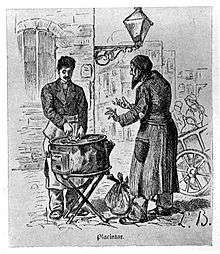Placenta cake
| Type | Pie |
|---|---|
| Place of origin | Roman Empire |
| Main ingredients | Flour and semolina dough, cheese, honey, bay leaves |
| Variations | plăcintă |

Placenta is a dish from ancient Rome consisting of many dough layers interspersed with a mixture of cheese and honey and flavored with bay leaves, then baked and covered in honey.[1][2] Cato included a recipe in his De Agri Cultura (160 BC).[3] Cato writes:
Shape the placenta as follows: place a single row of tracta along the whole length of the base dough. This is then covered with the mixture [cheese and honey] from the mortar. Place another row of tracta on top and go on doing so until all the cheese and honey have been used up. Finish with a layer of tracta...place the placenta in the oven and put a preheated lid on top of it ... When ready, honey is poured over the placenta.[2]
It derives from the Greek term plakous (Ancient Greek: πλακοῦς, gen. πλακοῦντος – plakountos, from πλακόεις - plakoeis, "flat") for thin or layered flat breads,[4][5][6] and Andrew Dalby considers it, and surrounding dessert recipes in Cato, to be in the "Greek tradition," possibly copied from a Greek cookbook.[7] A flowery description of plakous was left by the Greek poet Antiphanes (fl. 3rd century BC).[8]
A number of scholars suggest that the Roman dessert's Eastern Roman (Byzantine) descendants, plakountas tetyromenous ("cheesy placenta") and koptoplakous (Byzantine Greek: κοπτοπλακοῦς), are the ancestors of modern tiropita (börek or banitsa) and baklava respectively.[9][2][10] The name placenta (Greek: "πλατσέντα") is used today on the island of Lesbos in Greece to describe a baklava-type dessert of layered pastry leaves containing crushed nuts that is baked and then covered in honey.[11][12][13] Another variant of the Roman dish survived into the modern era as the Romanian plăcintă cake.
Through its Greek name plakountos, it was adopted into Armenian cuisine as plagindi, plagunda, and pghagund, all "cakes of bread and honey."[14] From the latter term came the later Arabic name iflaghun, which is mentioned in the medieval Arab cookbook Wusla ila al-habib as a speciality of the Cilician Armenians settled in southern Asia Minor and settled in the neighboring Crusader kingdoms of northern Syria.[14] Thus, the dish may have traveled to the Levant in the Middle Ages via the Armenians, many of whom migrated there following the first appearance of the Turkish tribes in medieval Anatolia.[15]
References
- ↑ "American Pie". American Heritage. April–May 2006. Archived from the original on 2009-07-12. Retrieved 2009-07-04.
The Romans refined the recipe, developing a delicacy known as placenta, a sheet of fine flour topped with cheese and honey and flavored with bay leaves.
- 1 2 3 Faas, Patrick (2005). Around the Roman Table. University of Chicago Press. p. 184-185. ISBN 0226233472.
- ↑ Cato the Elder. "De Agricultura".
- ↑ placenta, Charlton T. Lewis, Charles Short, A Latin Dictionary, on Perseus
- ↑ πλακοῦς, Henry George Liddell, Robert Scott, A Greek-English Lexicon, on Perseus project
- ↑ placenta, Concise Oxford English Dictionary Luxury Edition, Oxford University Press, 2011
- ↑ Dalby, Andrew (1998). Cato on farming-De Agricultura-A modern translation with commentary. p. 21.
We cannot be so sure why there is a section of recipes for bread and cakes (74-87), recipes in a Greek tradition and perhaps drawing on a Greek cookbook. Possibly Cato included them so that the owner and guests might be entertained when visiting the farm; possibly so that proper offerings might be made to the gods; more likely, I believe, so that profitable sales might be made at a neighbouring market.
- ↑ Dalby, Andrew (1998). Cato on farming-De Agricultura-A modern translation with commentary. p. 155.
Placenta is a Greek word (plakounta, accusative form of plakous 'cake'). 'The streams of the tawny bee, mixed with the curdled river of bleating she-goats, placed upon a flat receptacle of the virgin daughter of Demeter [honey, cheese, flour], delighting in ten thousand delicate toppings – or shall I simply say plakous? I'm for plakous' (Antiphanes quoted by Athenaeus 449c).
- ↑ Rena Salaman, "Food in Motion the Migration of Foodstuffs and Cookery Techniques" from the Oxford Symposium on Food Cookery, Vol. 2, p. 184
- ↑ Speros Vryonis The Decline of Medieval Hellenism in Asia Minor, 1971, p. 482
- ↑ ΠΟΛΙΤΙΣΤΙΚΟ ΙΔΡΥΜΑ ΟΜΙΛΟΥ ΠΕΙΡΑΙΩΣ, ΜΑΓΕΙΡΕΥΟΝΤΑΣ ΜΕ ΛΑΔΙ ΚΑΙ ΑΛΛΑ ΣΤΗΝ ΑΓΙΑ ΠΑΡΑΣΚΕΥΗ ΛΕΣΒΟΥ
- ↑ http://www.bostanistas.gr/?i=bostanistas.el.article&id=3528
- ↑ Λούβαρη-Γιαννέτσου, Βασιλεία (2014). Τα Σαρακοστιανά 50 συνταγές για τη Σαρακοστή και τις γιορτές (Lent foods: 50 recipes for Lent and the holidays).
Η πλατσέντα είναι σαν τον πλακούντα των αρχαίων Ελλήνων
- 1 2 Perry, Charles. "Studies in Arabic Manuscripts," in Rodinson, Maxime, and Arthur John Arberry. "Medieval Arab Cookery." (2001). p. 143
- ↑ Bozoyan, Azat A. (2008). "Armenian Political Revival in Cilicia". In Hovannisian, Richard G.; Payaslian, Simon. Armenian Cilicia. UCLA Armenian History and Culture Series. United States: Mazda Publishers. p. 68. ISBN 1-56859-154-3.